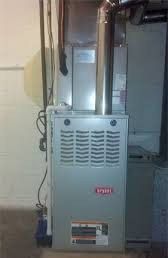Questions about My Furnace
What does the furnace efficiency rating mean?
Furnace efficiency is measured by Annual Fuel Utilization Efficiency, or AFUE, and is displayed as a percentage, from 80% to 97%. The higher the percentage, the more efficient the furnace is. The AFUE number tells you how much heat is produced compared to the amount of energy is used. Here is a simple way to look at it. If you have an 80% furnace, for every $1 you spend in gas for that furnace, 80 cents is going toward heating your house and 20 cents is wasted, going up the chimney. For a 97% furnace, 97 cents is going toward heating your house and 3 cents is wasted.
How efficient is my furnace?
The simplest way to tell is by examining the materials used to vent the furnace exhaust. If metal piping is used for the vent, then your furnace is 80% efficient or lower. If a plastic PVC material is used for the vent, then your furnace is 90% efficient or higher. Many times with the higher efficient furnaces, two PVC pipes will be connected to the furnace. One is bringing air into the furnace, the other is exhaust from the furnace.

This is an 80% efficient furnace

This is an 90% efficient furnace
How often should my furnace be checked?
It is important to have your furnace checked annually. In fact, if you read your owner's manual for your furnace, it will have a section where it recommends annual maintenance to be performed by a qualified service technician. All furnace manufactures recommend this. You can compare it to your car. Your car requires regular oil changes and maintenance to keep operating properly. If you ignore servicing your car, it may run fine for a while, but eventuelly a lot more things will break and it will ultimately shorten the life of your engine. The same is true with your furnace, if you ignore the annual maintenance, your furnace will become more prone to breakdowns, and eventually that major breakdown that leaves you with no heat in the middle of winter. Approximately 75% of emergency no-heat service calls can be linked to a lack of maintenance.
Do I need a new furnace?
Here is the short answer: The average life span of a furnace is 15-20 years. That being said, I have had to replace a furnace that was only 6 years old, and others that were 40 years old and more. There are multiple factors that contribute to the life span of a furnace, including proper sizing, installation, and maintenance. If a furnace is not sized properly for the space it needs to heat, this affects both the life span and the efficiency of the furnace. Likewise, if the duct work attached to the furnace is not sized properly, this can have an adverse effect on the equipment as well.
Here are some things to think about when considering a new furnace:
-
Age of the furnace.
-
Operation of the furnace. Am I constantly having to get my furnace fixed?
-
Does it keep my house comfortable in the winter, or does it seem to run constantly and the house is still cold? Maybe there is a sizing issue.
-
Efficiency. Do I have a lower efficiency furnace and want to upgrade to a High efficiency furnace?


